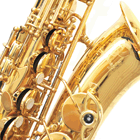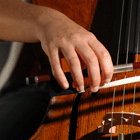
Research on focal dystonia...
Research Project Publications | Conferences
Patrice has published several scientific papers on focal dystonia, and offers treatment and rehabilitation for task-specific dystonia affecting musicians, also called musician's dystonia.
March 2014 - Focal Dystonia publications available on this website
Both the original study published in 2010, and the 4-year follow-up study published in 2013 in Medical Problems of Performing Artists are now available for download in PDF, with kind permission of the publishers "Science and Medicine" (USA). You can download the full articles here.
Research 2007/2010 - Focal Hand Dystonia affecting musicians in Scotland - Two publications available in "Medical Problems of Performing Artists" (click here to view).
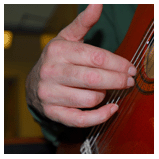 |
Focal dystonia is characterised by an involuntary and painless task-specific loss of control of one or more digits of the hand. On this picture, the guitar player is unable to control his right ring finger. The finger tends to curl into the palm of the hand involuntarily. |
Recent research in neurology has shown that the condition is associated with
changes in areas of the brain involved with the control of movement, and especially distortions in the representational zones of the digits in an area of the somatosensory cortex. The reason for these neurological changes may be due to the highly repetitive and almost simultaneous finger movements that musicians have to practise.
Dystonia is a very difficult condition to treat successfully, and recovery is more often partial than complete. Many musicians affected by dystonia are unable to continue their professional career.
However, several treatment protocols exist, aiming at reversing these neurological changes taking place in the brain. Patrice has recently started a research study with a few bagpipers, two guitar players, two flute players, and an oboe player affected by focal hand dystonia. The study has been approved by the Ethics Committee at Glasgow Caledonian University, and data collection has now started.
The protocol involves a combination of sensory motor retuning (SMR), using splints to immobilise specific fingers (pictures below), and slow-down exercise therapy (SDE) in order to reinforce normal patterns of movement at slow speed. The musicians taking part will be monitored up to one year in order to evaluate their progress.
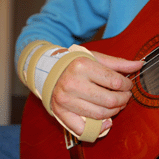 |
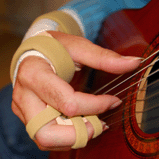 |
Results - Focal Hand Dystonia Research
Preliminary results of the Focal Hand Dystonia study, which has been ongoing since 2007, have been presented by Patrice at the Third International Conference on Movement Dysfunction (website), held in Edinburgh at the end of October 2009. These preliminary results involve a guitar player and a flute player. You can read the conference abstract here.
Final results of this study were presented at the 28th Annual Conference on "Medical Problems of Performing Artists", held in Snowmass, Colorado at the end of July 2010. You can read the conference abstract here.
This research study has now been published in the December 2010 issue of the medical journal Medical Problems of Performing Artists. To get the reference of the article, go to the list of publications.
A 4-year long-term follow-up of this study was completed in March 2012. The full results were presented at the 30th Annual Symposium on "Medical Problems of Performing Artists", Snowmass, Colorado, July 2012; and at IFOMPT 2012 - World Congress of Musculoskeletal Physiotherapy, Quebec, Canada, October 2012. This 4-year follow-up has just been published in Medical Problems of Performing Artists in March 2013 (list of publications).
Video Clips - Focal Hand Dystonia Research
You can watch a series of video clips showing a guitar player:
- sensory motor retuning (4MB),
- playing before treatment (8MB),
- playing after 6 months (8MB) of therapy,
- playing after 12 months (8MB) of therapy.
Please note the tendency of the fourth finger to curl and the fifth finger to compensate by extending in the "before treatment" video clip. These movement patterns are greatly reduced after six months of sensory motor retuning. After 12 months, the guitar player can play the test piece with no visible dystonic pattern.
| Clinics 7 Hillfoot Drive Bearsden G61 3QQ (Map) 07766 687578 |






